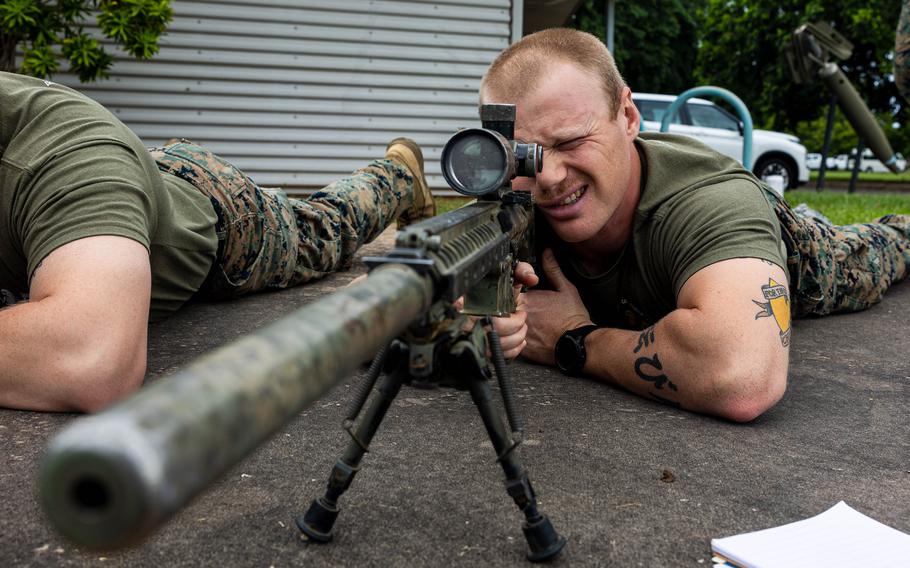
Marine Corps Staff Sgt. Alex Aman looks down the sight of an M110 Semi-Automatic Sniper System at Robertson Barracks in Darwin, Australia, April 5, 2024. (Juan Torres/U.S. Marine Corps)
Australia, already in partnership with the Pentagon on several fronts, would welcome an even larger U.S. presence under President-elect Donald Trump, Australian defense experts said Wednesday.
The United States has sent growing numbers of troops Down Under since 250 Marines kicked off annual rotations to the country’s northern port of Darwin in 2012.
The force, which operates in Australia from April to October, has grown to over 2,000 members.
Australian security researchers predict the U.S. under Trump will accelerate its growing military presence in their country as it seeks to deter China and disperse its forces to make them less susceptible to enemy missiles.
Australia is already spending $450 million in U.S. funds to build air bases in the Northern Territory to accommodate rotations of U.S. B-52 Stratofortress bombers, Pacific Air Forces commander Gen. Kevin Schneider said in July.
And the U.S. and United Kingdom are building five nuclear-powered submarines for Australia, part of the AUKUS pact, for deployment in 2027, the first delivery in a program expected to cost $250 billion over three decades.
The Trump administration will seek to ramp up the size of the Marine rotational force several fold, Australian defense researcher Allan Orr told Stars and Stripes by email Tuesday.
“Likely at least 10,000 Marines and likely permanent if they get their way,” he said.
Australia would prefer a permanently stationed force of 10,000-20,000 troops, Orr said, adding that the Marines should move forces from Japan to Australia as soon as possible.
“Moving these positions from a country where their presence is much more politically protested to Australia and out of most Chinese missile ranges would be ideal for both sides,” he said.
The U.S. and Australian governments have wanted to increase the American military presence for more than a decade, Orr said.
“If anything, the U.S footprint is evolving too slowly,” he said.
Australia needs to add missile defense, more runways for strategic bombers and enough troops to make sure the deployment deters China, Orr added.
Mike Green, chief of the United States Studies Centre in Sydney, told The Australian in a Nov. 7 report that ramped-up American deployments to Australia would be part of a bipartisan plan for a more distributed military posture in the region.
“They’re going to come in on day one and want to accelerate co-operation with Australia on defence,” he told the newspaper. “If there is an issue, frankly, it’s that the (Australian) government is going to come under pressure to spend more on defence.”
Australian military spending roughly matches the NATO target of 2% of gross domestic product.
“He (Trump) might also request a further boost in our defence budget — perhaps to 3% of GDP — within a few years,” former Australian assistant defense secretary Ross Babbage told Stars and Stripes by email Wednesday.
It’s possible that the Trump administration may want Australian units to operate more frequently with U.S. forces in the Far East and for Australia to accelerate efforts to build missiles to supply Australian and U.S. units, he said.
“Further US operations in and from Australia are anticipated over time and are almost always universally welcomed here,” he said. “They are rarely controversial.”
However, Paul Buchanan, an American security expert based in New Zealand, said Trump could scale back the U.S. commitment to the Indo-Pacific.
“The MAGA (Make America Great Again) people are neo-isolationist,” he said by phone Wednesday. “They want to withdraw American military commitments all around the world.”
The U.S. Congress has pushed back on the AUKUS commitment, contending it distracts from efforts to grow the U.S. submarine force, Buchanan said.
“I’m not convinced [Trump] considers the Western Pacific the region of priority,” he said.